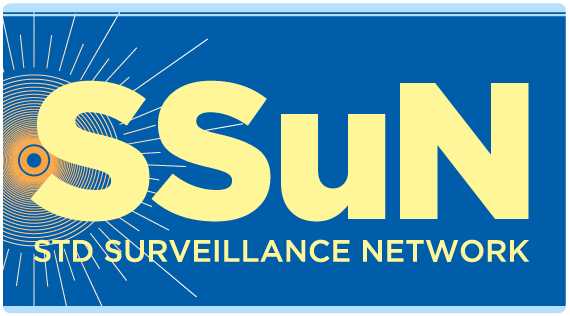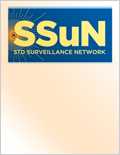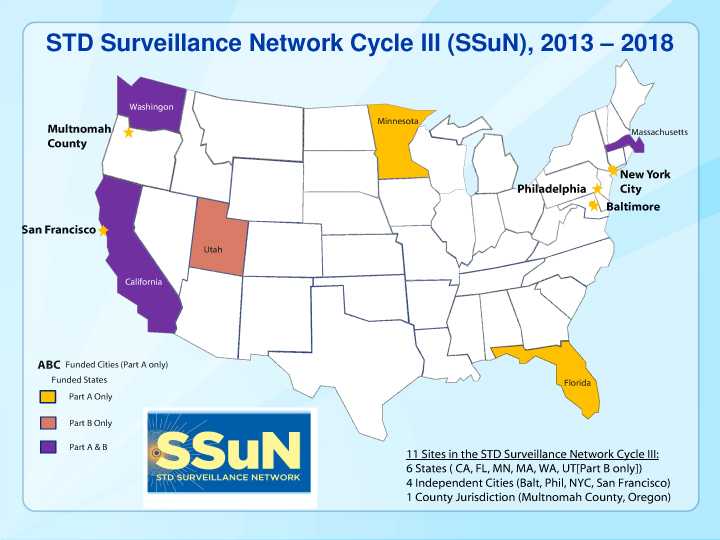STD Surveillance Network (SSuN)
On this Page

Protocol
Overview
The purpose of the STD Surveillance Network (SSuN) is to provide enhanced behavioral, demographic, and clinical information on gonorrhea cases reported to state and local health departments, to provide information on patients presenting for care in STD and family planning clinical settings, and to explore evolving health information technologies to improve STD surveillance nationwide. This information will allow CDC, as well as state and local health departments, to better understand the epidemiology of STDs and to inform national and local STD prevention efforts.
SSuN is a collaboration of competitively-selected state, county, and city health departments that are provided funding to address STD surveillance problems of national, state, and local interest. The network was established in 2005 and is currently in Cycle 3 of funding under a cooperative agreement for activities ongoing through 2018 (CDC-RFA-PS13-1306). There are two major components of SSuN, each addressing different issues in STD surveillance and prevention.
Part A of SSuN Cycle 3 provides support for selected health departments to implement a range of population-level and facility-based activities constituting the core functions of the network. Data from these two activities are stripped of all specific identifying information and sent to CDC using standardized formats and industry-standard confidentiality and security measures.
Funded health departments doing population-level activities select a random sample of reported gonorrhea cases and obtain additional information from providers about the clinical presentation of these cases. They also interview patients to obtain additional demographic and behavioral information such as age, race and Hispanic ethnicity, gender of recent sex partners, symptoms, and treatment received.
Funded health departments also conduct facility-based sentinel surveillance in specialty STD clinics and in facilities providing reproductive health services. For these clinical settings, information on patient visits are obtained, including STD tests performed at the visit, diagnoses received, and demographic and some behavioral characteristics of the patient. Sentinel surveillance is designed to provide evidence of trends in patients seeking care, trends in provider testing practice, and changes in the number and proportion of patients diagnosed with STDs.
Part B Cycle 3 of this announcement funds four health departments to implement robust and sustainable local collaborations with healthcare partners in their jurisdiction to obtain electronic health data necessary for monitoring STD prevention, measure clinical services delivered to patients, and assess STD-related health outcomes across a wide range of provider settings and data sources. Activities funded under Part B are considered projects of “inherent national significance” because of their potential applicability to STD programs nationwide.
Through this combination of collaborative activities, SSuN provides uniform, comprehensive information on a representative sample of STD cases and provides health departments with STD-related healthcare trend information not currently available from any other source. The following sections provide additional information about the specific data collected, participating jurisdictions, recent publications, and contact information of SSuN project officers.
STD Surveillance Network Collaborators
- Baltimore City Health Department (Cycles 2 & 3 [Part A])
- Jefferson County Health Department, Birmingham, AL (Cycle2)
- California Department of Public Health (Cycle 3 [Part A & B])
- Chicago Department of Public Health (Cycle 2)
- Colorado Department of Health and Environment (Cycles 1 & 2)
- Florida Department of Health(Cycle 3[Part A])
- Los Angeles County Department of Public Health (Cycle 2)
- Massachusetts Department of Public Health(Cycle 3 [Part A & B])
- Minnesota Department of Health (Cycles 1 & 3[Part A])
- Multnomah County Health Department, Portland, OR (Cycle 3)
- New York City Department of Health and Mental Hygiene (Cycles 1, 2 & 3[Part A])
- Philadelphia Department of Public Health (Cycles 2 & 3[Part A])
- San Francisco Department of Public Health (Cycles 1, 2 & 3 [Part A])
- Utah Department of Health (Cycle 3 [Part B])
- Virginia Department of Health (Cycles 1 & 2)
- Washington State Department of Health (Cycles 1, 2 & 3 [Part A & B])
Currently Funded Jurisdictions
CDC SSuN Contacts
Lisa Llata, MD,MPH
LCDR, USPHS
SSuN Co-Project Officer
Surveillance and Special Studies Team
Division of STD Prevention, NCHHSTP
Centers for Disease Control and Prevention
1600 Clifton Road, Mail Stop E-63
Atlanta, GA 30333
(O) 404-639-6183
(F) 404-639-8610
ellata@cdc.gov
Mark R. Stenger, M.A.
Epidemiologist, SSuN Co-Project Officer
Surveillance and Special Studies Team
Division of STD Prevention, NCHHSTP
Centers for Disease Control and Prevention
1600 Clifton Road, Mail Stop E-63
Atlanta, GA 30333
(O) 404-639-6136
(F) 404-639-8610 (fax)
mstenger@cdc.gov
- Page last reviewed: February 9, 2016
- Page last updated: June 24, 2016
- Content source:


 ShareCompartir
ShareCompartir

